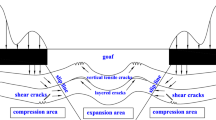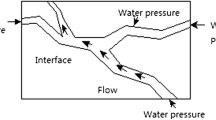Abstract
When mining at great depth, high-pressure karstic water inrush can pose a serious threat. We used physical simulations to investigate channel inception, evolution, and catastrophic flooding. Using newly developed coupled solid–liquid materials and physical simulations of high-pressure water intrusion, a laboratory test was carried out that reproduced the spatial and temporal characteristics of channel formation and crack generation, extension, connection, and failure. Floor failure features caused by the effects of mining and confined water were analyzed, and the formation and evolution of catastrophic flooding were investigated. The results showed that the evolution of a water-inrush channel can be divided into three stages: floor crack development, water channel initiation, and channel evolution. Extrapolating the simulation results to a real-world example, a floor fracture formed when the working face advanced to 45 m, and a water-inrush channel formed when the push distance of the working surface was about 70 m. Thereafter, the point of water eruption widened, water flow increased, and the main cracks in the floor rock mass showed obvious changes. The crack in the lower interface was angled 56° upward, and finally a water eruption point formed in the middle of the mined cavity. These results provide theoretical support for the prediction of water inrush into deep coal mines.
Resumen
En la minería a gran profundidad, la irrupción de agua a alta presión representa un serio riesgo. Hemos usado simulaciones físicas para investigar el comienzo de los canales, su evolución y las inundaciones catastróficas. Usando materiales sólido-líquidos recientemente desarrollados y simulaciones físicas de irrupción de agua a alta presión, se llevó a cabo un ensayo de laboratorio que reproduce las características espacio-temporales de formación de canales y de generación de grietas, extensión, conexión y fallas. Se analizaron las fallas del piso causadas por el efecto de la minería y del agua confinada y se investigaron la formación y evolución de inundaciones catastróficas. Los resultados mostraron que la evolución de canales de irrupción de agua puede ser dividida en tres estadíos: desarrollo de una grieta en el piso, iniciación de canal de agua y evolución del canal. Al extrapolar los resultados de la simulación a un ejemplo de la vida real, se encontró la formación de una fractura cuando el perfil de trabajo avanzó 45 m y se formó un canal de irrupción de agua cuando la superficie de trabajo avanzó 70 m. A partir de entonces, el punto de erupción del agua se amplió, el flujo de agua aumentó y las grietas principales en la masa de roca del suelo mostraron cambios obvios. La grieta en la interface menor estaba inclinada 56° hacia arriba y finalmente un punto de erupción de agua se formó en el medio de la cavidad minada. Estos resultados proveen soporte teórico para la predicción de irrupción de agua en minas profundas de carbón.
Zusammenfassung
Eine ernsthafte Gefahr für Bergbau in großen Teufen stellen Wassereinbrüche von unter hohen Drücken stehenden Karstgrundwässern dar. Mit Hilfe physikalischer Simulationen wurden Bildung und Entwicklung von Fließwegen sowie der katastrophenartige Flutungsprozess untersucht. Auf Basis neuartiger, gekoppelter Fest-Flüssig-Material- und Prozesssimulationen von Hochdruckwasserintrusionen wurden mittels Laborversuch die räumlichen und zeitlichen Charakteristika von Rissbildung, -erweiterung und Versagen reproduziert. Die Merkmale von durch Bergbau und gespannte Wässer verursachten Liegenddurchbrüchen wurden ebenso analysiert wie der Hergang des Überflutungsvorgangs. Im Ergebnis konnte gezeigt werden, dass sich die Entwicklung der zum Wassereinbruch führenden Fließwege in drei Phasen vollzieht: Rissbildung an der Grubenbausohle, beginnende Bildung von Fließwegen, sowie Entwicklung und Erweiterung der Fließwege. Die Übertragung der Testergebnisse auf ein reales Beispiel führte zu folgenden Schlussfolgerungen: Die Rissbildung an der Grubenbausohle begann nach Fortschreiten der Verhiebsfront bis 45 m, zur Bildung eines Fließweges kam es, als die Entfernung zur Verhiebsfront ca. 70 m betrug. Anschließend vergrößerte sich die Wassereintrittsstelle, die Zuflussmenge stieg an, und die Hauptrisse in der Sohle zeigten deutliche Veränderungen. Die Spalte an der unteren Grenzfläche besaß eine Neigung von 56°, und schließlich kam es in der Mitte des Grubenbaus zu einer Wassereruption. Die Ergebnisse liefern theoretische Erkenntnisse für die Vorhersage von Wassereinbrüchen in tiefen Kohlegruben.
大采深矿井底板高压水突水物理模拟
底板高压岩溶水突水是大采深矿井的主要安全威胁。物理模拟了突水通道形成、演化和致灾过程。利用新研发的流-固耦合材料和高压水模拟装置,建立了室内物理模拟模型,再现裂纹产生、扩展、联通和破断的突水通道形成过程。分析了采矿活动和底板水压引起的底板破坏特征和灾害性突水发生过程。试验结果表明,突水通道形成分为三个阶段:底板裂纹扩展、突水通道形成和突水通道演化。将模拟结果应用于工程实例发现,当工作面推进45m时,底板裂纹形成,推进70m后突水通道形成。之后,突水点扩大,水流增大,底板主要裂缝明显变化,裂缝向上倾角56°,最终在采空区中间形成突水点。研究为大采深矿井底板突水预测提供了理论支持。.












Similar content being viewed by others
References
Feng M, Mao X, Bai H (2009) The study on the law of bearing coal floor aquifuge fracture evolution. J Rock Mech Geotech Eng 28(2):336–341 [Chinese]
Hu Y, Zhao Y, Yang D (2007) The study of 3D solid-liquid coupling simulation stope deformation. J Liaoning Techl U 26(4):520–523 [Chinese]
Hui G, Niu S, Jing H, Wang M (2010) Physical simulation on deformation rules of gob-side roadway subjected to dynamic pressure. J Min Safe Eng 27(1):77–81 [Chinese]
Li S, Feng X, Li S (2010a) A new preparation and application of solid-fluid coupling similar materials. J Rock Mech Geotech Eng 29(2):281–288 [Chinese]
Li S, Li L, Li S (2010b) Preparation and application of water inrush physical model test system in underground engineering. J Min Safe Eng 27(03):299–304 [Chinese]
Li S, Zhou Y, Li L (2012) A new preparation and application of Fluid-solid coupling similar materials. J Rock Mech Geotech Eng 31(6):1128–1137 [Chinese]
Li Z, Xie H, Li J, He Z (2014) Experimental study of mining effect on collapse column activated water conducting mechanism. J Central South U 45(12):4377–4383 [Chinese]
Shi L, Xin H, Zhai P (2012) The height of water flowing fractured zone calculation under deep mining conditions. J China U Min Tech 41(1):37–41 [Chinese]
Sun W, Zhang S, Li Y, Lu C (2015) development application of solid-fluid coupling similar material for floor strata and simulation test of water-inrush in deep mining. J Rock Mech Geotech Eng 34(S1):2665–2670 [Chinese]
Wu Q, Wang M (2006) Characterization of water bursting and discharge into underground mines with multi-layered ground-water flow systems in the north China coal basin. Hydrogeol J 14(6):882–893
Wu Q, Wang M, Wu X (2004) Investigations of groundwater bursting into coal mine seam floors from fault zones. Int J Rock Mech Min Sci 41(4):557–571
Xu Y, Chen X, Li J (2013) Experimental research on floor heave and water inrush in the broken rock roadway under great depth and high water pressure. J China Coal Soc 38(S1):124–128 [Chinese]
Yu B, Zhu W, Xu J (2007) Numerical simulation of surface subsidence characteristics during deep mining. J Min Saf Eng 24(4):422–426
Zhang J, Hou Z (2001) Study on solid-liquid coupling similar materials. J Rock Mech Geotech Eng 23(18):3157–3161 [Chinese]
Zhang J, Wang J (2006) Coupling application of rock stress and seepage in engineering. J Rock Mech Geotech Eng 25(10):1981–1989 [Chinese]
Acknowledgements
This research was financially supported by the National Natural Science Foundation of China (Grants 51404146 and 51274132), China Postdoctoral Science Foundation (Grant 2015M572067), Post-doctoral Innovation Project of Shandong Province (Grant 152799), Key R & D Projects in Shandong Province (Grant 2015GSF120016), Qingdao Postdoctoral Applied Research Project (Grant 2015203), Key Laboratory of Safety and High-efficiency Coal Mining Ministry of Education (Anhui University of Science and Technology) (Grant KLMME12101), and Mining Institute Science and Technology Innovation Foundation of Shandong University of Science and Technology (Grant KYKC17001).
Author information
Authors and Affiliations
Corresponding authors
Rights and permissions
About this article
Cite this article
Sun, W., Zhang, S., Guo, W. et al. Physical Simulation of High-Pressure Water Inrush Through the Floor of a Deep Mine. Mine Water Environ 36, 542–549 (2017). https://doi.org/10.1007/s10230-017-0443-7
Received:
Accepted:
Published:
Issue Date:
DOI: https://doi.org/10.1007/s10230-017-0443-7




